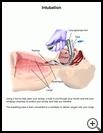
Intubation
________________________________________________________________________
KEY POINTS
- Intubation is a procedure to place a tube through your child’s mouth and into the windpipe. The tube keeps the airway open and helps your child breathe by letting air flow into and out of the lungs.
- Intubation may be done as an emergency or as a planned procedure. Your child may have this procedure if your child has an injury or condition that makes it hard to breathe.
- Ask your provider how long it will take to recover and how to take care of your child at home.
________________________________________________________________________
What is intubation?
Intubation is a procedure to place a tube through your child’s mouth and into the windpipe. The tube keeps the airway open and helps your child breathe by letting air flow into and out of the lungs. The tube may be attached to a machine, called a ventilator, to help your child breathe.
When is it used?
Your child may need intubation if he or she is not able to get enough air and oxygen into the lungs. It may also be needed to protect your child’s lungs from damage if your child’s gag reflex isn’t working well. These may happen if:
- Your child has narrowing or a blockage in the airway from swelling or burns.
- Your child has an infection or narrowing in the airway caused by asthma, pneumonia, or other disease.
- Your child is unconscious after a drug overdose or severe injury.
- Your child needs a ventilator to help breathe.
- Your child is having general anesthesia for surgery.
What happens during the procedure?
This procedure is usually done at the hospital. In rare cases, it may be done at the scene of an accident or cardiac arrest.
Your child will be given medicine to relax and keep from feeling pain. Your child’s healthcare provider will use a tool to help open your child’s airway and guide a tube through the mouth or nose and into your child’s airway. Your child’s provider may connect the breathing tube to a ventilator. The ventilator will help deliver oxygen into your child’s lungs a set number of times per minute.
What happens after the procedure?
Depending on your child’s condition, your child may stay in the hospital for a few hours or days. The breathing tube will stay in as long as your child needs it to protect the airway or help with breathing.
The breathing tube will be removed when:
- Your child is breathing well enough without help
- Your child doesn’t need the support of the ventilator
- There is no longer a need to protect your child’s airway with the tube
Follow the healthcare provider's instructions. Ask your provider:
- How long it will take your child to recover
- If there are activities your child should avoid and when your child can return to normal activities
- How to take care of your child at home
- What symptoms or problems you should watch for and what to do if your child has them
Make sure you know when your child should come back for a checkup. Keep all appointments for provider visits or tests.
What are the risks of this procedure?
Every procedure or treatment has risks. Some possible risks of this procedure include:
- Your child may have problems with medicine given for relaxation.
- Your child may have an infection or bleeding.
- Your child may have damage to the voice box or problems with swallowing.
Ask your healthcare provider how the risks apply to your child. Be sure to discuss any other questions or concerns that you may have.
Last modified: 2021-06-01
Last reviewed: 2019-08-22

